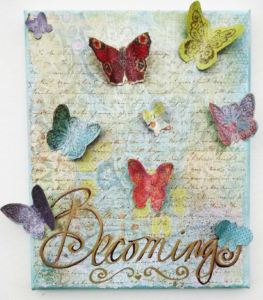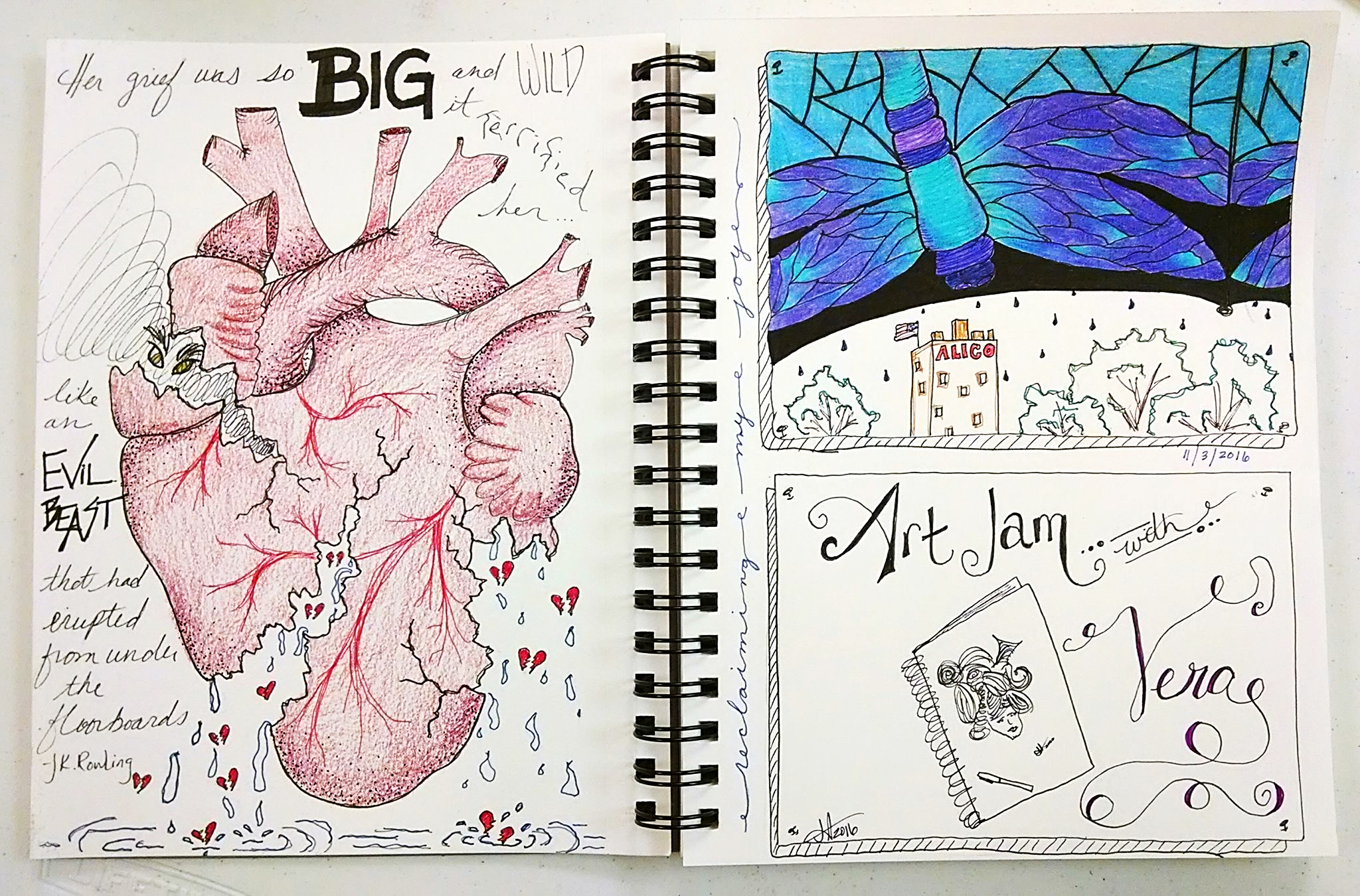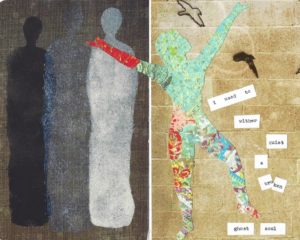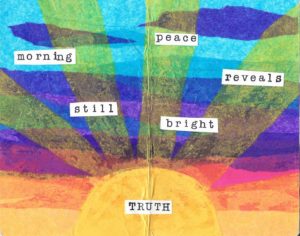The Art of Coping
By Jennifer Alumbaugh
The integration of creative process with therapy has been a long tradition in the mental health field. It is used to “explore feelings, reconcile emotional conflicts, foster self-awareness, manage behaviors, addictions, and coping, develop social skills, improve reality orientation, reduce anxiety, and increase self esteem,” according to the American Art Therapy Association, “the goal in art therapy is to improve or restore a client’s functioning and their sense of personal well-being.” The creative process using visual arts of writing, painting, drawing, sculpture, mixed media, music, and other expressions, allow people to connect with their subconscious and to other parts of themselves beyond where language can take us. For some people who experienced trauma at pre-verbal stages of development, or during a time when they were learning their first language, but now only speak a second language, engaging in a visual process facilitates that connection to feelings and experiences for which a person may not have language.

(Original mixed media canvas by Jennifer Alumbaugh, LMFT)
The physical act of creating, using our hands to make, to shape, to move a medium around a page or a canvas or a block of clay, also connects us to different levels of our selves which allows for insights, awareness, and coping that is accessible beyond traditional “talk therapy.” In working with couples and families, creative process engages people to complete tasks, to work cooperatively, to see glimpses of the other’s thoughts and experience in fresh ways that can move a couple or family through conflict, through grief, through challenges, through communication toward a place of healing and wholeness.
When I consider the realm of mental health, I gather into that the following experiences: mental illness, grief and loss, and trauma recovery. Because while grief is not a mental illness, the experience of loss can result in mental health concerns. And while having survived a trauma incident or complex trauma is not a mental illness, the resulting PTSD, cPTSD, and other diagnoses are mental health issues. One of the things I love about using creative process in session with clients, is how art can help disrupt patterns of automatic thinking and can boost a client up out of a rut. Sometimes we create a visual representation of the emotion they are most struggling with: fear, sadness, anxiety, grief, anger. Sometimes it looks like a monster; sometimes it is a looming shadow; sometimes it is a silly creature that makes a client laugh instead of being afraid; sometimes they are small, pocket-sized beasts; sometimes they are great larger-than-life manifestations.

(Original mixed media drawing by Jennifer Alumbaugh, LMFT; quote by J.K. Rowling)
Naming those feelings—actual people names—and creating a visual image of them, helps to externalize the process. For me, grief is Harold and depression is Gertrude. They show up often, like uninvited guests, and over stay their welcome! But when I create caricatures out of these feelings, and create goofy personas to go with them, it shifts the power balance and gives me the chance to call the shots—to decide whether or not I let them in, or how long they get to stay. It is the same for clients. When we name and externalize our struggles, it separates them from us—so we are not afraid, fear is visiting us. We are not depressed; depression crashed our party. We are not anxiety; anxiety interrupted our meeting. Art gives us the tools to create a tangible, concrete representation of that with which we are coping bringing it out of the abstract and into the finite. Once we accomplish that, then we can feel more empowered to cope, manage, and control our feelings and experiences.

Original mixed media artwork and poem by Jennifer Alumbaugh, LMFT, 2016
There are many people who engage in creative expression outside of the context of a therapy session and who find that process to be therapeutic. There is something deeply satisfying about creating with our own two hands. For many, the act of creating is a soothing, meditative, practice. For me, I call it a “mind vacation,” because when I am making art, that is the only thing my mind is thinking about. I feel joy. I feel peace. I feel delight. Even when I mess up—which is often, I appreciate my process and everything I learn along the way.
I’ve been a poet and spoken-word artist for a long time and I found incredible release in exploring my grief, depression, and trauma recovery, through the medium of poetry. But I have found that the process is twofold—there is the creating, and then there is the sharing. I found that it wasn’t enough to create for myself and by myself and that as I began to share my work with others, I found this extraordinary, medicinal “me too.” Sharing my creative expression, my interpretation, my attempts to make meaning out of my experiences, it connected me with others who had also survived, struggled, and coped with similar things. I learned that I am not alone. And I learned that my creative expressions give others permission to feel and to question and to work through their own experiences. I realized that when we share our process of healing, coping, recovering, with others, there is no place for shame to grow and fester. Alongside all of the therapy work I was doing, sharing and listening and seeing others’ creative process moved me along the healing path as well.

(Original mixed media collage and poem by Jennifer Alumbaugh, LMFT)
Waco has a unique opportunity to engage, as a community, in creative process exploring the intersections of heart, mind, body, and soul in the upcoming Central Texas Artist Collective (CTAC) EKPHRASIS Exhibit. The call for artists will open May 1-31st and will invite both visual artists and poets to enter to be paired with a buddy—visual artists with poets and poets with visual artists. Each duo will then have 4 months to collaborate creating a visual piece and a poem which will be displayed together in shop windows along Austin Avenue and other downtown areas opening on the 1st Friday in November 2017. The theme for each creative pair will be to explore mental health, grief and loss, and/or trauma recovery. This will be a powerful experience in the process, in the exhibit, and in the viewing. The goal is to bring many stigmatized realities to light, normalize mental health experiences, and empower one another in our coping. For complete details on how to enter EKPHRASIS Waco! please visit the CTAC information page here.
 Jennifer Alumbaugh, MS is a Licensed Marriage and Family Therapist providing clinical and professional development consultation services at Enrichment Training and Counseling Solutions. She has extensive experience working with adolescent and adult survivors of psychological and spiritual abuse, trauma (sexual violence, childhood trauma, interpersonal violence); and complex PTSD. These, along with grief and loss work are her areas of specialization. Jennifer practiced as a mental health clinician throughout Los Angeles County working with children, youth, and their families from 2007-2012. In Central Texas, Jennifer has worked as a Site Coordinator with Communities in Schools of The Heart of Texas at G.W. Carver Middle School; as an independent consultant and professional development trainer; and conference speaker. In 2016 Jennifer created an implemented a therapeutic creative writing program, Brave Young Voices, at Klaras Center for Families and at the Texas Juvenile Justice Department correctional campus at Mart, TX. She may be reached at: [email protected] or 254-405-2496.
Jennifer Alumbaugh, MS is a Licensed Marriage and Family Therapist providing clinical and professional development consultation services at Enrichment Training and Counseling Solutions. She has extensive experience working with adolescent and adult survivors of psychological and spiritual abuse, trauma (sexual violence, childhood trauma, interpersonal violence); and complex PTSD. These, along with grief and loss work are her areas of specialization. Jennifer practiced as a mental health clinician throughout Los Angeles County working with children, youth, and their families from 2007-2012. In Central Texas, Jennifer has worked as a Site Coordinator with Communities in Schools of The Heart of Texas at G.W. Carver Middle School; as an independent consultant and professional development trainer; and conference speaker. In 2016 Jennifer created an implemented a therapeutic creative writing program, Brave Young Voices, at Klaras Center for Families and at the Texas Juvenile Justice Department correctional campus at Mart, TX. She may be reached at: [email protected] or 254-405-2496.
The Act Locally Waco blog publishes posts with a connection to these Aspirations for Waco. If you are interested in writing for the Act Locally Waco Blog, please email [email protected] for more information.
